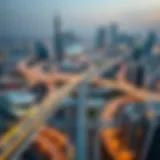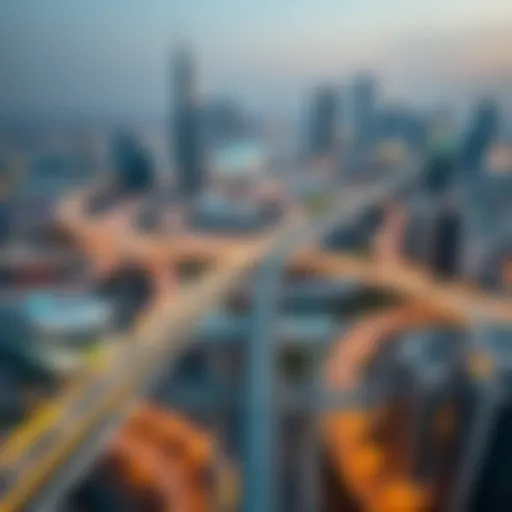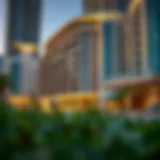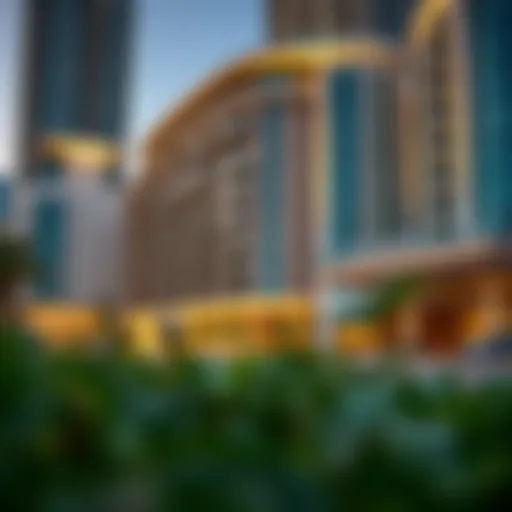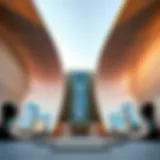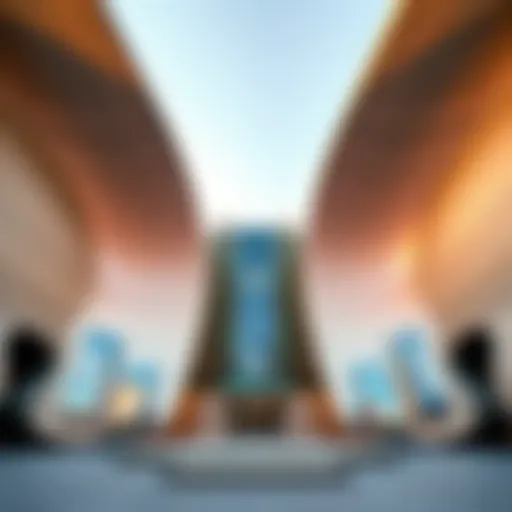City Tower on Sheikh Zayed Road: Insights and Analysis
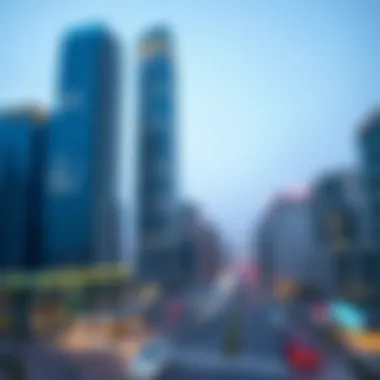

Intro
City Tower stands out as a notable emblem on Sheikh Zayed Road, a pivotal artery within Dubai's bustling landscape. Recognized not only for its striking facade but also for its substantial role in shaping the city’s real estate narrative, City Tower invites a closer examination. The tower, with its unique architectural presence, plays a crucial role in both the commercial and residential markets. A brief exploration into its history offers invaluable context, revealing how this iconic structure has morphed alongside the rapid development of Dubai.
As interest in the Dubai real estate sector swells, understanding the dynamics surrounding City Tower becomes paramount for investors and analysts alike. This article provides a rigorous analysis of the tower's architectural significance, market trends, investment potential, and its broader influence within the setting of real estate.
Through this lens, we’ll navigate the peculiarities of current market conditions, investment opportunities, and the evolving environment that surrounds City Tower. The essence of this analysis is to arm prospective buyers, seasoned investors, and industry professionals with the insights necessary to make informed decisions, particularly as they relate to this dazzling landmark.
Let’s delve into the market trends that echo around City Tower.
Preamble to City Tower
City Tower stands as a noteworthy example of Dubai's rapid development and transformation into a global hub. This section aims to provide readers with insights into the significance of City Tower, particularly highlighting its role along Sheikh Zayed Road, which itself is a vital artery in Dubai’s connectivity and urban landscape. As the skyline of this bustling city evolves, understanding the key points regarding City Tower allows investors, agents, buyers, and analysts to navigate opportunities present in the real estate market.
Overview of Sheikh Zayed Road
Sheikh Zayed Road stretches over 50 kilometers, acting like the backbone of Dubai's metropolitan area. It connects various key locations, including major business districts, shopping centers, and residential neighborhoods. This road is more than just a transportation route; it's a symbol of modernity and economic vigor. Its significance cannot be overstated because it attracts not only locals but also visitors from all over the world, contributing significantly to the city’s vibrancy.
The road’s landscape is dotted with architectural marvels, including skyscrapers, luxury hotels, and commercial complexes. Many of these structures house corporate offices and provide amenities that support a thriving business environment. By offering superior accessibility and visibility, Sheikh Zayed Road enhances the value of real estate located along its stretch, including City Tower.
Importance of City Tower in Dubai
City Tower occupies a strategic position on Sheikh Zayed Road, making it an essential part of Dubai's urban fabric. It serves both functional and symbolic purposes, as it reflects the city's architectural ambition and economic growth. Here are its key attributes that solidify its importance:
- Architectural Distinction: Its design sets it apart from other buildings in the vicinity, exemplifying modern architectural trends.
- Business Hub: The tower provides prime office spaces, drawing various businesses that seek to establish a foothold in Dubai's competitive market.
- Cultural Symbol: It embodies the spirit of a young and ambitious city, attracting interest from tourists and locals alike.
City Tower's presence along such a critical thoroughfare not only elevates its profile but also adds to the overall allure of Sheikh Zayed Road, underscoring its role in shaping Dubai's future. As we move through this comprehensive analysis, each aspect of City Tower will become clearer, further defining its part in this dynamic urban setting.
"Understanding the significance of City Tower is crucial for anyone looking to invest in Dubai's jolting real estate market."
In summary, the upcoming sections will delve into City Tower’s architectural features, the surrounding market dynamics, and its impact on the community, all holding vital information for potential investors and stakeholders.
Architectural Features of City Tower
The architectural features of City Tower are not only a testament to modern design but also reflect the cultural dynamics of Dubai. This section analyzes the design elements, construction materials and techniques, as well as sustainability practices that characterize the tower’s impressive structure. Understanding these components is crucial for future investors, buyers, and analysts, as they encapsulate not just the aesthetic value, but also the functional essence of this landmark within the context of Dubai.
Design Elements
City Tower exhibits a unique blend of contemporary aesthetics and traditional influences which sets it apart from other buildings along Sheikh Zayed Road. The tower’s façade is visually stunning, featuring sleek lines and an innovative use of glass, which allows natural light to flood the interior spaces, creating an inviting atmosphere that resonates with both business and leisure sectors.
- Curvilinear Form: The design incorporates a curvaceous outline, harmonizing with the landscape while providing a sense of fluidity.
- Iconic Entrance: The main entrance designed with high ceilings portrays grandeur and is often illuminated by ambient lighting, enhancing the visitor experience.
- Open Layout: Inside, the open layout facilitates a flow of movement and creates multifunctional spaces that can be adapted for various uses, essential for both commercial and residential properties.
These elements not only add to the tower's visual appeal but also embody innovative design that encourages interactions among the occupants and visitors, making it a hub of activity.
Construction Materials and Techniques
The construction of City Tower wasn't just about putting one brick on another; it was a sophisticated process that involved various high-quality materials and advanced techniques.
- Reinforced Concrete: The primary material utilized is reinforced concrete, providing structural integrity capable of withstanding potential harsh climatic conditions as well as seismic activities.
- High-Performance Glazing: Windows crafted from high-performance glazing not only optimize energy efficiency but also reduce noise pollution, which is particularly valuable in the bustling environment around Sheikh Zayed Road.
- Modular Construction: Some components of the tower were prefabricated off-site, which reduced construction time significantly while maintaining high standards of quality.
This careful selection of materials and innovative construction methods helps ensure that City Tower remains functional and appealing for years to come.
Sustainability Practices
As global awareness about sustainability grows, City Tower stands as a model of eco-friendly architecture in Dubai. This commitment to sustainability is manifested through various practices integrated into both the design and operation of the building.
- Energy Efficient Systems: The tower is equipped with energy-efficient lighting and HVAC systems, significantly reducing the overall energy consumption compared to conventional buildings.
- Water Management: A sophisticated water recycling system is in place to manage resources wisely, which is critical in a region where water scarcity is a pressing issue.
- Green Roofs and Vertical Gardens: These elements not only enhance the aesthetic aspects of the building but also contribute to biodiversity and help in insulating the structure.
"Sustainability is not just a trend; it is a necessity for urban development, especially in a rapidly evolving city like Dubai."


The integration of these sustainable practices underscores City Tower's role as a forward-thinking establishment that not only caters to present needs but also considers future generations.
Market Dynamics Around City Tower
Understanding the market dynamics surrounding City Tower is crucial for anyone seriously considering real estate investment or development in the area. This section unpacks the nuanced interplay of property values, nearby developments, and growth trends that collectively shape the market narrative around this landmark.
Current Property Values
The property values near City Tower fluctuate based on a multitude of factors. As of late 2023, the average price for properties in this vicinity has settled at around AED 1,700 per square foot, which reflects both demand and the desirability of the location. Investors are drawn to this figure, particularly as it shows resilience in the face of broader economic uncertainties. Comparing this to other regions in Dubai, like Downtown or Dubai Marina, the prices are relatively competitive. The integration of high-end amenities and proximity to essential services plays a significant role in keeping these property values buoyant.
Moreover, notable sales have occurred in recent months, indicating an upward trend in investment interest. Some have reported properties selling at prices exceeding AED 2,000 per square foot, signaling strong demand from buyers. Factors like historical significance, architectural appeal, and accessibility contribute significantly to maintaining such vigorous pricing. In particular, investors are keen to secure properties in areas poised for future growth, making the current valuation a point of contention and excitement.
Comparative Analysis with Nearby Developments
When evaluating City Tower, it is essential to consider its standing in relation to nearby developments. For instance, towers like the Burj Khalifa and Emirates Towers command attention for their iconic stature, yet City Tower has cultivated its own reputation through strategic positioning.
- Direct Comparisons:
- Burj Khalifa: Known for its luxury condominiums, typically priced over AED 3,500 per square foot.
- Emirates Towers: Offering office spaces with rental ranges of AED 150 to AED 300 per square foot, which appeals to businesses.
City Tower, while not as luxurious as some of these high-profile constructions, presents a viable option for both commercial and residential purposes, particularly appealing to middle-income investors and tenants looking for affordability in a prime location. The blend of affordability with a solid location in Sheikh Zayed Road creates a unique position in the market. This competitive stance fuels interest from both investors and tenants alike, as the space blends accessibility, pricing, and amenities effectively.
Investment Growth Trends
Investment growth trends around City Tower reveal a landscape marked by cautious optimism. Recent statistics indicate a significant uptick in foreign direct investment, particularly from Asian markets. Many investors are considering Dubai as a safe-haven, especially in light of fluctuating oil prices and geopolitical tensions elsewhere.
- Key points to note:
- Increased foreign interest in real estate,
- Potential for capital appreciation in the near future,
- Ongoing governmental initiatives to foster economic diversification further support this growth.
The next couple of years will likely see even more projects in and around City Tower, which can only drive property values higher. Investors are particularly keen on understanding how these trends marry with other macroeconomic factors.
Investment experts suggest that properties around City Tower could offer significant returns in the coming decade, especially considering the region's relentless push for innovation and infrastructure development.
In summary, as the area surrounding City Tower continues to evolve, it becomes essential for analysts and investors alike to keep their finger on the pulse of the market. The interplay of rising property values, competitive positioning with nearby developments, and encouraging growth trends all contribute to a complex but promising investment landscape.
Rental Market Insights
The rental market surrounding the City Tower is a pivotal aspect when analyzing its overall impact on the real estate landscape of Dubai. For investors and analysts, understanding rental dynamics is crucial since it directly influences investment decisions and market behavior. An influx of tenants can signal robust demand, while shifts in rental yield can indicate wider economic trends.
Rental Yield Potential
When assessing the rental yield potential of City Tower, a few factors come into play. The prime location along Sheikh Zayed Road undoubtedly enhances its appeal, drawing both residents and businesses alike. Depending on the amenities available and the suite of offerings in City Tower, rental yields can vary. Generally speaking, properties in high-demand areas like this can achieve yields between 6% and 8%, which is attractive to investors looking for fruitful returns.
Additionally, external economic indicators, such as government policies on real estate and fluctuations in tourism, further influence these figures. As the overall economic environment stabilizes, we can anticipate a positive trajectory in rental yields.
Tenant Demographics
Understanding tenant demographics is invaluable. The draw of City Tower isn't limited to just its structural design; it's also about the people it attracts. Tenants range from young professionals to established corporations seeking office space. These individuals often prefer modern facilities that blend work and lifestyle seamlessly.
A diverse tenant mix can also affect stability and demand. You may find single professionals renting one-bedroom apartments, while families look for larger units. Analyzing these demographics allows investors to tailor their strategies accordingly.
Lease Terms and Regulations
Knowledge of lease terms and the governing regulations is essential. In Dubai, the Rental Disputes Center oversees rental agreements, ensuring fair practices are followed. Most leases range from one to three years, and understanding these stipulations helps in predicting turnover rates and occupancy levels.
Moreover, the local market mandates transparency in lease agreements, particularly concerning rental increases and tenant rights. Investors and owners must navigate these rules proficiently to avoid disputes and to foster positive landlord-tenant relationships.
In summary, the rental market insights surrounding City Tower not only provide investors with a clear view of the current landscape but also equip them with the knowledge to make informed decisions moving forward. Identifying potential yields, understanding tenant demands and being aware of regulations can significantly enhance one's investment acumen in this vibrant real estate environment.
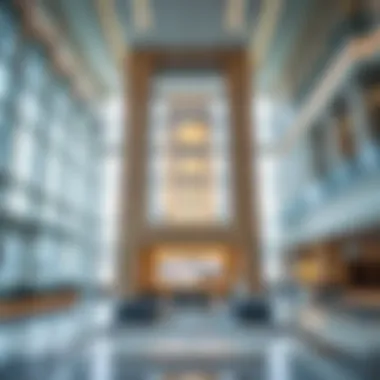

Impact of City Tower on the Neighborhood
City Tower stands as more than just a prominent skyscraper on Sheikh Zayed Road; it embodies the pulse of a dynamic neighborhood. Understanding its impact reveals layers of economic, cultural, and social significance. The tower influences its surroundings, offering advantages that range from enhanced business opportunities to shaping community interactions.
Economic Contributions
City Tower plays a pivotal role in bolstering the local economy. Its presence attracts numerous businesses, thus creating a synergy that benefits surrounding retail and service sectors. To put it plainly, the tower is a major driver for employment generation.
- Job Creation: Numerous firms established within City Tower contribute to thousands of jobs, from corporate roles to service positions.
- Increased Foot Traffic: The influx of employees and visitors stimulates the local shops, restaurants, and services nearby. More customers to the area means more revenue for businesses that rely on foot traffic.
- Investment Catalyst: The tower has also sparked interest from investors looking to develop residential and commercial properties nearby.
In a nutshell, the economic prospects associated with City Tower extend well beyond its walls, fostering growth and revitalization in the wider community.
Cultural Significance
Culturally, City Tower acts as a landmark, symbolizing Dubai’s rapid urbanization and its blending of modernity with tradition. It stands tall not just in stature, but also in the narrative of Dubai’s evolution.
- Local Identity: The design and prominence of the tower contribute to a distinct identity for the neighborhood. Many view it as a symbol of growth and forward-thinking.
- Cultural Spaces: Within the vicinity, spaces for cultural events, art exhibitions, and community gatherings have emerged, profoundly enriching the local tapestry.
- Visitor Attraction: The tower also draws tourists, thereby bolstering cultural exchange as visitors from various backgrounds explore local customs and cuisine.
City Tower isn't just a part of the skyline; it forms an integral part of the community's cultural heart, fostering an environment where tradition and modernity coexist.
Social Infrastructure Developments
The impact of City Tower on social infrastructure cannot be understated. The tower serves as a catalyst for improvements in public and social facilities in the neighborhood.
- Enhanced Transportation Services: With the increase in population density, local transportation services have been revamped. Public transit options have expanded to accommodate the rise in commuters, helping to alleviate congestion in the area.
- Community Amenities: Adjacent to City Tower, there are developments of parks, recreational spaces, and community centers, which serve as essential social gathering points.
- Health and Education Facilities: The growth spurred by City Tower has ushered in new health care and educational institutions, providing residents with better access to essential services.
Overall, the tower has not only reshaped the urban landscape but also significantly contributed to the social framework of the neighborhood. Its presence influences local dynamics, fostering community through thoughtful development and infrastructure enhancement.
City Tower’s influence extends into various facets of life, weaving economic, cultural, and social threads into a rich narrative that reflects community resilience and growth.
This progressive ripple effect emphasizes City Tower’s role as a catalyst for neighborhood improvement, making it a focal point of modern urban living.
Accessibility and Transportation
When discussing the viability and appeal of real estate properties, accessibility and transportation can not be overlooked. The City Tower, strategically positioned along Sheikh Zayed Road, serves as a nexus for both residents and businesses due to an intricate web of transportation options. This connectivity amplifies the tower's marketability and value, ultimately impacting investment potential.
Proximity to Public Transit
Being near public transportation is a significant selling point for any urban property. City Tower has the luxury of being in close range of multiple transit options. The Dubai Metro’s red line is within walking distance, facilitating swift commutes for professionals working in the surrounding business districts.
Moreover, the availability of bus services adds another layer of ease for those who prefer to rely on public transit. With buses running at frequent intervals, commuters can enjoy minimized wait times. This is crucial, especially during peak hours when the streets get crowded.
The presence of a nearby tram system further enhances accessibility, allowing residents and visitors easy movement throughout the city.
“Public transportation can serve as the lifeblood of urban living, especially in a bustling hub like Dubai.”
Road Connectivity
Sheikh Zayed Road itself is a vital artery that connects several key areas within Dubai. The road not only provides direct access to other major highways but also seamlessly connects residents to Dubai Marina, Downtown Dubai, and the Dubai International Airport. This unparalleled road connectivity is instrumental for both personal and business travel, making City Tower an appealing option for those who prioritize easy access to other parts of the city.
The assortment of road options caters to various traffic needs, allowing for smooth transitions between different parts of the sprawling metropolis. Traffic management initiatives in this area often contribute to reducing congestion, which means smoother rides for drivers and less time spent in traffic.
Impact on Commuters
The implications of this integrated transportation network are significant for commuters. Reducing travel time is a key factor, especially for those who juggle long work hours and personal commitments. Being in proximity to efficient public transportation means that individuals can reclaim valuable time that would otherwise be spent navigating heavy traffic.
Additionally, a well-connected property like City Tower plays a role in attracting diverse tenant demographics. Young professionals, families, and expatriates often seek locations that minimize transit time and facilitate ease of access to key amenities.
Furthermore, with Dubai's emphasis on sustainability, the availability of transportation options allows for reduced reliance on private vehicles. This not only lessens carbon footprints but also contributes to a more livable urban setting.
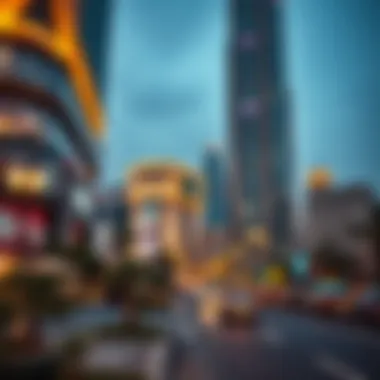

Future Developments Near City Tower
The landscape around City Tower is poised for notable transformations, as various projects emerge to reshape not just the horizon but also the dynamics of this bustling area. As investors and analysts focus their gaze on Sheikh Zayed Road, understanding the forthcoming developments is crucial. Such projects can significantly influence property values, rental yields, and the overarching economic environment. In short, keeping tabs on these changes is a smart move for anyone who has a stake in this ever-evolving market.
Upcoming Projects in the Area
Numerous initiatives are on the drawing board or already underway close to City Tower. These projects range from new residential buildings to commercial hubs and leisure facilities. A few key developments include:
- The Dubai Creek Tower: Set to be a new landmark, this project aims to outshine even the Burj Khalifa, further boosting tourism and residential appeal in the vicinity.
- New Residential Complexes: Developers are introducing multiple high-rise apartments tailored to meet the demands of a diverse population, enhancing living options for families and young professionals alike.
- Retail Centers: Expanding shopping areas are critical. New malls are planned, accommodating local and international brands, promising to create a vibrant shopping experience for residents and visitors.
Each of these projects holds the potential to affect the real estate ecosystem significantly, not only attracting new residents but also enhancing the commercial appeal of the area. The increased footfall could lead to better opportunities for businesses, making this locality more vibrant.
Projected Market Trends
The real estate market is always a dance of predictions and responses, and the emergence of new developments around City Tower indicates a shifting rhythm. Analysts are eyeing several key trends:
- Increase in Property Values: As demand surges due to new projects, property values along Sheikh Zayed Road are expected to rise, making it an attractive location for investment.
- Shift in Demographics: With new residential offerings, the demographic profile of residents may shift. Young professionals and expatriates are expected to flock to the area, which can drive demand for specific amenities and services.
- Enhanced Infrastructure: The ongoing improvements in transport and accessibility will certainly support growth in the real estate market, making commuting easier and, therefore, raising property desirability.
By staying informed about these projected trends, stakeholders can make better decisions whether they are looking to buy, invest, or simply understand the market landscape. As developments transpire, being ahead of the curve is not just beneficial; it's essential.
"Investing in an area before it becomes the next hot spot is like planting a seed before the rain. Timing is everything."
Thus, as the future unfolds for City Tower, the surrounding projects are likely to reshape not just the skyline but also the market itself.
Tourism and Hospitality Influence
Tourism and hospitality play a pivotal role in the economic landscape surrounding City Tower. This area, situated on the bustling Sheikh Zayed Road, draws visitors not just for its architectural splendor but also for the vibrancy and business activities it hosts. The proximity to significant landmarks and attractions enriches the appeal of City Tower, making it a center of attention for tourists and investors alike.
Attractions Nearby
The allure of City Tower is amplified by its closeness to various tourist hotspots. Just minutes away, the Dubai Mall stands as one of the world's largest shopping centers. Visitors flock here not just to shop, but also to enjoy the spectacular Dubai Aquarium and the city’s famous fountain shows.
Another crown jewel nearby is the Burj Khalifa, which casts its impressive shadow on the surrounding area. Tourists from around the globe stop to take pictures and experience the breathtaking views from its observation decks. The unique experience offered by Al Fahidi Historical Neighborhood, not far from City Tower, transports visitors back to the roots of Emirati culture, where they can wander through traditional wind-tower architecture and explore galleries and museums that tell the story of Dubai’s past.
In addition to these iconic attractions, the area is dotted with restaurants, cafes, and entertainment venues that cater to diverse tastes, enhancing the overall tourism experience.
Impact on Local Businesses
The influx of visitors and professionals to City Tower indeed brings a ripple effect on local businesses. Shops, restaurants, and services see a remarkable increase in foot traffic, leading to higher sales and revenue opportunities. Businesses that capitalize on this growth include those offering retail goods, dining, and hospitality services.
- Retail Sector: Several boutiques and brand stores have emerged, taking advantage of the steady stream of potential customers.
- Cafes and Restaurants: The culinary scene thrives, with various establishments providing local and international cuisine, catering to the palate of tourists and locals alike.
- Service Industry: Services such as travel agencies, car rentals, and guided tours have also seen a surge in demand, given the high volume of tourism.
Moreover, this economic boost from tourism fosters job creation within local communities, further enhancing the overall socio-economic fabric of the area. A thriving local economy benefits everyone involved—from business owners reaping the rewards to employees finding stable employment opportunities.
Overall, the interplay between tourism and local businesses near City Tower exemplifies how urban centers can cultivate a thriving ecosystem, grounded in hospitality and cultural exchange. In addition to that growth, it positions City Tower as a strategic asset for potential investors who recognize the ongoing demand for such environments in an increasingly globalized world.
The End
The conclusion section serves as a vital anchor for the previous discussions surrounding City Tower. By summarizing the key points, it effectively brings together the diverse threads explored throughout the article. The importance of this part cannot be overstated, especially for stakeholders such as investors, real estate agents, and analysts who seek to synthesize the information presented.
Summary of Key Insights
In this article, we’ve dissected numerous aspects of City Tower, revealing its architectural splendor and market dynamics. Here are the principal insights drawn from our examination:
- Architectural Significance: City Tower stands as a beacon of modern design, integrating cutting-edge technology with sustainability practices, enhancing its allure and functionality.
- Market Dynamics: Current property values reflect a healthy demand in the vicinity, influenced by comparative advantages over nearby developments. The tower's presence boosts not only rental yields but also contributes to a vibrant local economy.
- Cultural and Economic Impact: Beyond being a mere structure, City Tower plays a pivotal role in the socio-economic fabric of the area. It drives business growth while nurturing community culture.
- Transport and Accessibility: The tower’s strategic location along Sheikh Zayed Road ensures unmatched accessibility, making it convenient for residents and visitors alike. This aspect cannot be ignored when considering its investment potential.
Final Thoughts on City Tower's Potential
City Tower is more than just a physical entity; it embodies the transformative spirit of Dubai. As urban landscapes evolve, this landmark is poised for continued growth and development. Considering the trends highlighted in this analysis, prospective buyers and investors should take notice of the following:
- Continuous Development: With new projects sprouting nearby, City Tower is likely to benefit from increased visibility and foot traffic, definitive trends for arising investment opportunities.
- Long-Term Viability: The sustainability practices adopted in its design ensure that City Tower meets future demands while retaining value in an ever-changing market.
- Investment Opportunities: For those looking to dive deep into the Dubai real estate market, City Tower serves as a prime example of potential profit, especially given its location and established reputation.
"City Tower is not just a structure; it remains a symbol of what Dubai represents—a melding of innovation and tradition, making it a strikingly profitable investment avenue."
This synthesis highlights the essentials, while also calling upon stakeholders to reflect on the substantial benefits intertwined with City Tower. As the city continues to grow and adapt, so too does the potential of this iconic building. It stands as a testament to Dubai’s forward-thinking ethos and offers a promising landscape for future ventures.


